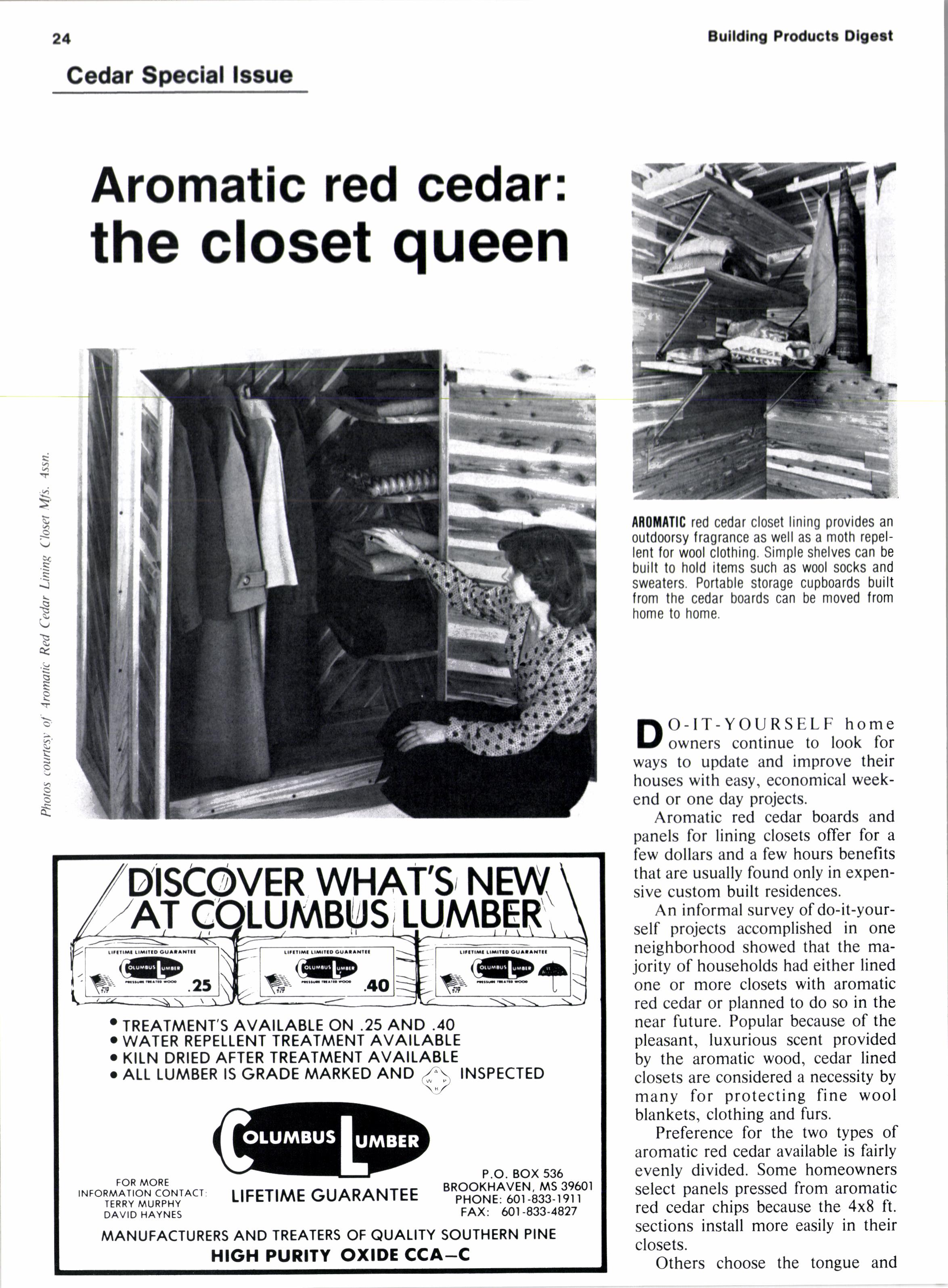
2 minute read
Aromatic red cedar: the closet queen
O-lT-YOURSELF home
owners continue to look for ways to update and improve their houses with easy, economical weekend or one day projects.
Aromatic red cedar boards and panels for lining closets offer for a few dollars and a few hours benefits that are usually found only in expensive custom built residences.
An informalsurvey of do-it-yourself projects accomplished in one neighborhood showed that the majority of households had either lined one or more closets with aromatic red cedar or planned to do so in the near future. Popular because of the pleasant, luxurious scent provided by the aromatic wood, cedar lined closets are considered a necessity by many for protecting fine wool blankets, clothing and furs.
Preference for the two types of aromatic red cedar available is fairly evenly divided. Some homeowners select panels pressed from aromatic red cedar chips because the 4x8 ft. sections install more easily in their closets.
Others choose the tongue and groove boards because they like the option of being able to apply them in a horizontal, vertical, angle or herringbone pattern. They also hnd the boards suitable for building shelves or storage cubicles. Many d-i-yers cover the closet floor as well as the ceiling and walls. Cedar boards come in 3/8" x 4" or 3/8" x 2" in 8 ft. lengths. They cut easily to the lengths needed.
Renters who want the luxury and protection of aromatic red cedar for their clothing and blankets line drawers with cedar boards or pieces of cedar panels or place them on existing shelves.
Aromatic red cedar products come packaged in cartons or bundles. They can be displayed as impulse items or cross merchandised with closet fixtures, paneling products and lumber. Because of the cur-
R&R Spending Keepo Glimbing
Expenditures on residential repair and remodeling soared during the 1980s, from $45 billion in 1982 to over $100 billion in 1988.
When adjustments are made for the impact of inflation, expenditures climbed 870/0. All regions shared in this growth. Economic and demographic fundamentals supporting R&R expenditures will remain solid for at least the next five years, pushing R&R expenditures from a little over $100 billion in 1988 to $133 billion in l99l and $168 billion in 1995. In inflation-adjusted terms, expenditures would rise from less than $85 billion in 1988 to $100 billion by the mid-1990s.
In 1987, an estimated 12.5 billion board feet (BBF) of softwood lumber were consumed in the R&R pro- rent emphasis on closet organization systems, customers are looking for such products. Builders and remodelers also are potential customers since aromatic red cedar lined closets are hot items in new homes and for remodeling jobs.
Story at a Glance
Summary of aromatic red cedar closet lining market tips on merchandising, displaying, advertising free materials.
Panels and boards can be suggested for other d-i-y projects. Free standing cupboards or additional storage closets in bedrooms, attics, basements and garages can be built
Gedar Special lssue
with them. The aromatic odor is excellent for freshening a musty basement. Some people like the scent well enough to panel a bathroom or other room with aromatic red cedar.
Dealers find that advertising the aromatic cedar panels and boards or scheduling clinics demonstrating how to improve closets with them encourages sales.
Free information on aromatic red cedar products including closet applications can be obtained by sending a self-addressed stamped envelope to: Home Closet Planning Service, 221 N. LaSalle St., Chicago, Il. 60601 - ed.
jects as well as 7.3 billion square feet (BSF) of softwood plywood; 1.5 BSF of OSB and waferboard; 3.3 BSF of sidings (most importantly vinyl)l and large volumes of windows, doors, cabinets, fencing and roofing materials. Combining changes in product usage trends with the increases in R&R expenditures, Resource Information Systems, Inc. forecasts further increases.
Softwood lumber consumption is expected to climb from 12.5 BBF in 1987 to 15.9 BBF by 1995, led by continued growth in the consumption of treated lumber. Between 1980 and 1987 the volume of treated lumber consumed in R&R projects more than quadrupled, reaching 4.3 BBF in 1987. Over the succeeding eight years, treated consumption is expected to grow an additional 750/0.









